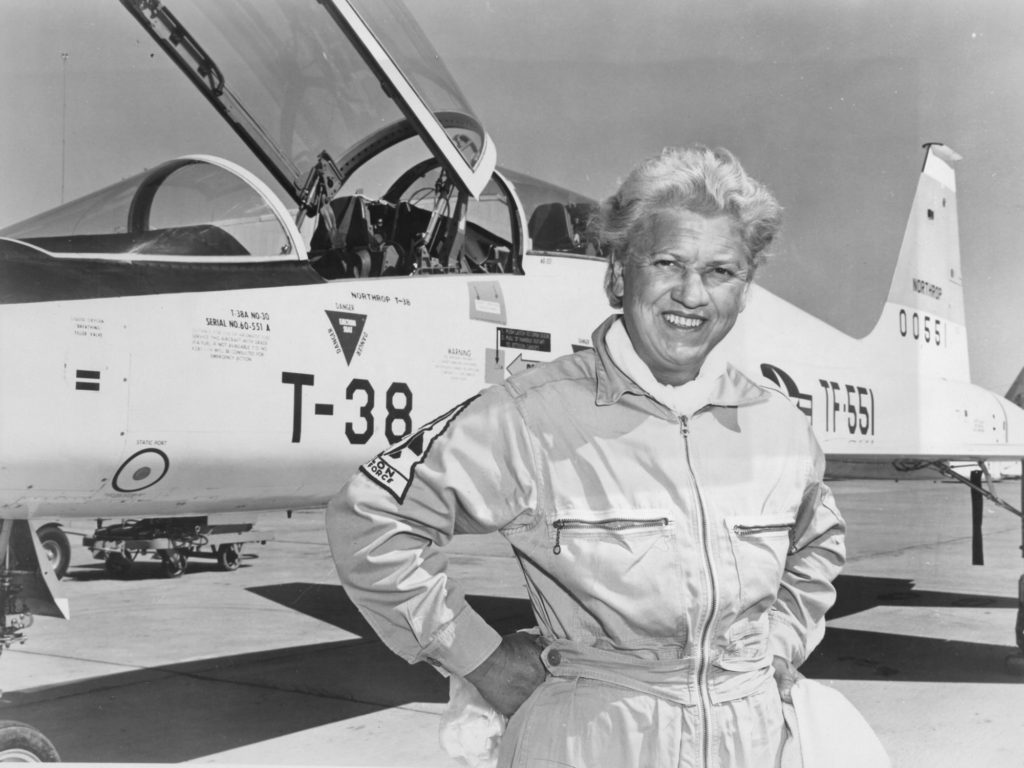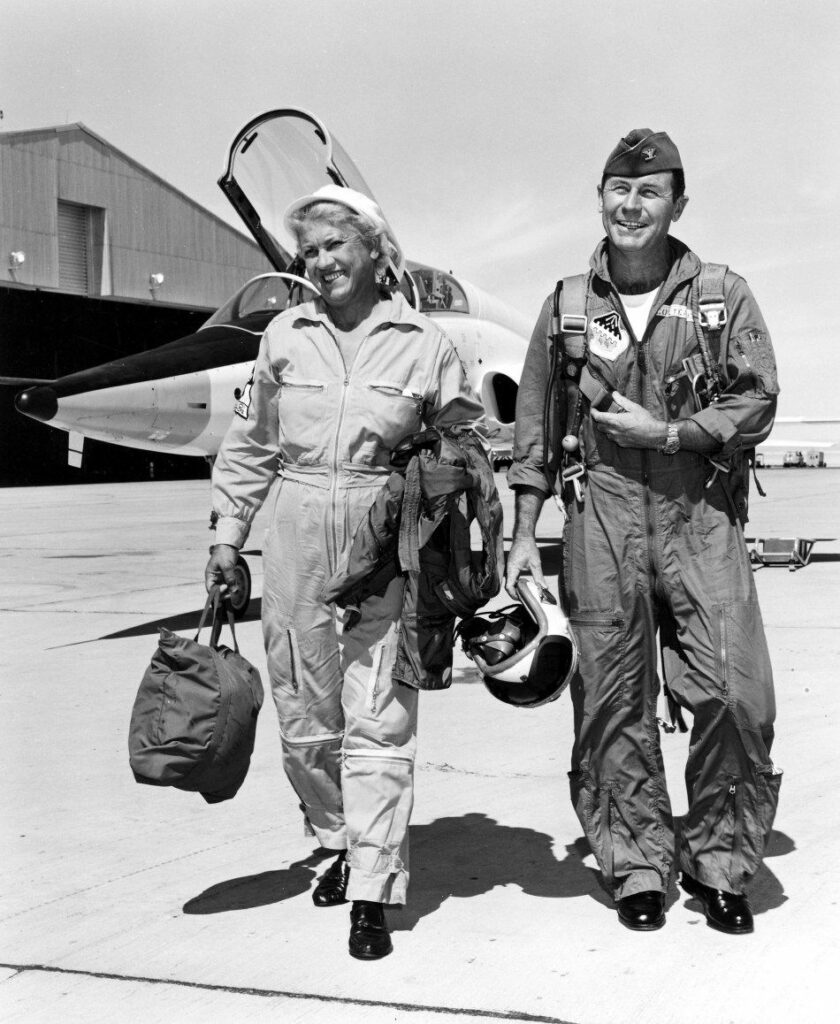Something inside Jacqueline Cochran always told her she would make her mark on the world. The woman who would earn the title "First Lady of Flight" did so and then some.
Born in May 1910, Jackie was raised by a foster family in extreme poverty. As a child, she toiled twelve hours a day, six days a week in a Georgia cotton mill where she earned 6 cents an hour. With her first paycheck, eight-year-old Jackie bought the first pair of shoes she ever owned – a pair of high heels.
The harsh environment that consumed her early years forged in Jackie an iron-clad resolve that would become the essence of her personality.
At age 14 she accepted a job in a Montgomery, Alabama beauty shop as a permanent-wave machine operator. By the time Jackie was 22, she had studied to become a nurse, worked for a doctor in a poor Florida town, and returned to the cosmetics industry as a hairdresser in New York City. Her talents in the salon produced a string of loyal clients, some of whom took her along as they wintered in Miami. It was at a Miami dinner party that Jackie and her destiny were formally introduced.
Floyd Odlum was a successful, self-made businessman. He represented all that Jackie dreamed of becoming, and her powerful personality intrigued him. When Jackie mentioned her idea of traveling around the country selling cosmetics and helping salons generate new business, Floyd remarked casually that she "would need wings" to do all that. The statement struck Jackie like a thunderbolt. Wings would indeed be useful, and she made up her mind to have them.
 There were few women pilots in 1932, but realizing goals others thought unreachable had driven Jackie since childhood. She enrolled in flying school and was immediately fascinated by every aspect of aviation. She displayed the feel for machinery that is crucial to understanding airplanes and their systems. The only real hurdle between her and a pilot's license was the written examination. Jackie worried that her lack of formal education would hinder her chances of passing the written test. Determined to earn her wings and never one to take no for an answer, she convinced the examiner to allow her to take the test orally. She had been told it would take three months to earn a pilot's license; she did it in three weeks.
There were few women pilots in 1932, but realizing goals others thought unreachable had driven Jackie since childhood. She enrolled in flying school and was immediately fascinated by every aspect of aviation. She displayed the feel for machinery that is crucial to understanding airplanes and their systems. The only real hurdle between her and a pilot's license was the written examination. Jackie worried that her lack of formal education would hinder her chances of passing the written test. Determined to earn her wings and never one to take no for an answer, she convinced the examiner to allow her to take the test orally. She had been told it would take three months to earn a pilot's license; she did it in three weeks.
Flying became Jackie's obsession. She flew all over the United States setting up her own cosmetics company and gaining valuable experience in the cockpit. In 1934, she entered her first air race. She flew a Gee Bee in the MacRobertson London-to-Melbourne competition and though mechanical failures prevented her from finishing, Jackie had contracted racing fever. The following year, the first of what would be many "firsts" for Jackie was achieved when she decided to enter the prestigious Bendix Transcontinental Air Race. Upon learning that women were not allowed to race in the Bendix, the ever-tenacious Jackie approached each male pilot scheduled to fly in the Los Angeles-to-Cleveland event. She asked for their signatures as proof that the men had no objections to her participation. Only after each man had signed was she granted permission to enter the competition, thus becoming the first woman to do so. Engine problems plagued her during the first leg of the race, and she did not complete the flight to Cleveland. Pride overshadowed her disappointment, however, as she realized the victory she had gained for women pilots by forcing the air racing fraternity to open its doors to female competitors.
Floyd was Jackie's greatest supporter. He encouraged her to continue racing, and the couple was wed in May 1936. The next year, she again entered the Bendix, taking first place in the women's division and third place overall. During the race, she also became the first woman to make a blind landing. In 1938, Jackie became the first woman to win the Bendix Transcontinental Air Race flying a Seversky pursuit airplane. Rough weather and fuel line troubles were no match for her determination and skill in the cockpit. When a judge approached her airplane in Cleveland to declare her the winner, he found Jackie putting on fresh make-up.
 Prior to U.S. involvement in World War II, Jackie participated in a program through the British Air Transport Auxiliary (ATA) whereby women pilots ferried aircraft to fighting units throughout England. She became the first woman to fly a bomber across the Atlantic. After returning stateside in 1943, she approached the government with the idea of developing a similar system for the U.S. Army Air Forces. A program known as the Women's Auxiliary Ferrying Squadron (WAFS) was in its infancy, and Jackie set about to improve the program to include better training and more flying opportunities for women pilots. The result of her efforts was the Women's Airforce Service Pilots (WASP). The WASP began with 25 women pilots, each hand-picked by Jackie. By 1945, more than 1,000 WASP had earned their wings and made significant contributions to the war effort. For her participation and leadership, Jackie became the first woman to receive the Distinguished Service Medal.
Prior to U.S. involvement in World War II, Jackie participated in a program through the British Air Transport Auxiliary (ATA) whereby women pilots ferried aircraft to fighting units throughout England. She became the first woman to fly a bomber across the Atlantic. After returning stateside in 1943, she approached the government with the idea of developing a similar system for the U.S. Army Air Forces. A program known as the Women's Auxiliary Ferrying Squadron (WAFS) was in its infancy, and Jackie set about to improve the program to include better training and more flying opportunities for women pilots. The result of her efforts was the Women's Airforce Service Pilots (WASP). The WASP began with 25 women pilots, each hand-picked by Jackie. By 1945, more than 1,000 WASP had earned their wings and made significant contributions to the war effort. For her participation and leadership, Jackie became the first woman to receive the Distinguished Service Medal.
The decade following World War II would see Jackie add to her list of aviation accomplishments in a big way. She was named Aviatrix of the Decade and received the Harmon Trophy in 1950. In 1953, under the guidance of Chuck Yeager, she became the first woman to break the sound barrier in a Canadian-built F-86 Sabre. During those flights, she also set a new world speed record of 652 miles per hour on a 100-kilometer course at Edwards Air Force Base. In 1959, she was chosen to serve as President of the Federation Aeronautique Internationale, the most prestigious international organization in aviation. Her list of aviation accomplishments continued to grow in the years that followed. She was the first woman to exceed Mach 2, to land a jet on an aircraft carrier, and to pilot a jet across the Atlantic. In 1963, her test flights in the military's F-104 Starfighter assisted in clearing the plane's reputation as a dangerous aircraft. In 1971, Jackie was enshrined in the National Aviation Hall of Fame and admitted to the Society of Experimental Test Pilots.
Jackie Cochran was a remarkable woman in the air and on the ground. She received more than 200 awards during her flying career and set speed, altitude and distance records that remain to this day. She passed away in 1980 at her home near Indio, California.
